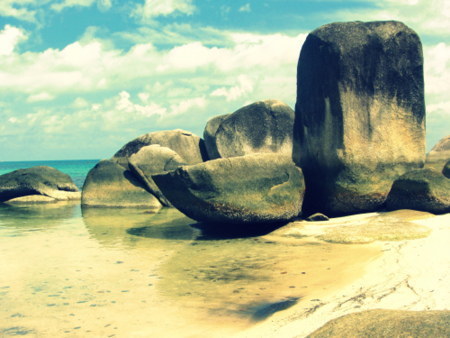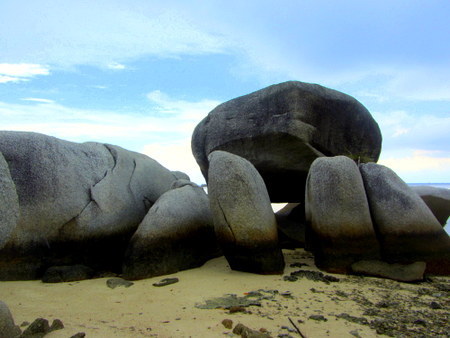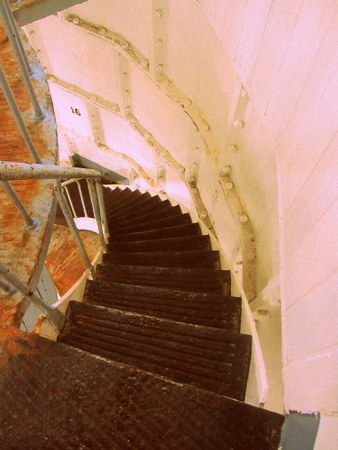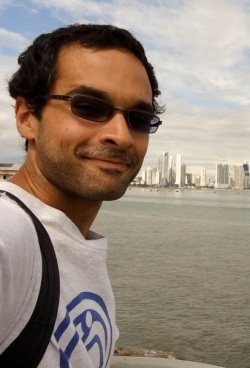Rolf Potts's Blog, page 64
April 9, 2013
Vagabonding Field Report: Camping in Northern Mexico
Vagablogging :: Rolf Potts Vagabonding Blog

Cost/day: $40/day
What’s the strangest thing you’ve seen lately?
Our family of seven is camping in Mexico beneath a full moon and enjoying a tranquil evening after crossing the border into this ‘dangerous’ country. Just the day before, we were warned that we were ‘risking our children’s lives’ by taking them to such a lawless place.’ Completely alone in a farmer’s field, we watched the sun peacefully set and then rise again the next morning on our first full day in Mexico.

Describe a typical day:
Rising with the sun, my husband and I read and study before our five children awake. Then we prepare breakfast and enjoy the morning together, before packing up and hitting the road again. Driving south, we stop for meals at roadside stands, then camp for the night in apple orchards, corn fields or forests.
Describe an interesting conversation you had with a local:
Stopping once for food, a mother of several children notices us, and sends two of her daughters over to ask for money. Believing that teaching children to beg is dehumanizing, I instead trade some apples for the chance to take a photograph.

What do you like about where you are? Dislike?
I love the wide open fields, the kind and friendly people, the feeling of safety, the comparative cleanliness of the country (our family has recently come from India, and according to my oldest daughter, “Mexico is like Utah, not dirty like India.”)
I dislike the negative stigma of ‘danger’ that shrouds the entire country, because of a few acts of violence by a small minority of criminals.

Describe a challenge you faced:
Placing the truck into reverse, a powerful lurch makes me believe we’ve hit a vehicle behind us. My husband puts the truck into drive and pulls into a parking lot. We discover that our rear brake has locked up. I envision what the night ahead holds for us — stranded in a strange Mexican town for who-knows-how-long, expensive mechanic repairs, a hotel, truck parts that we’ll be unable to find in the middle-of-nowhere-Mexico. Instead, a stranger offers help, calls his mechanic who comes to us and replaces the brakes within a few hours. Our stranger-turned-friend brings blocks of cheese from his store and guava for my children to eat. We share a very special evening with a man who goes out of his way to serve people who doesn’t know.
What new lesson did you learn?
Sometimes what we fear will happen is often worse than what actually happens. Often ‘bad’ experiences are great opportunities and great memories. There are kind and caring people all over the world who will go out of their way to help you.
Where next?
We’re headed further south into Mexico. Next stop, Lake Chapala. Read more about camping in Northern Mexico or connect with me on Facebook.
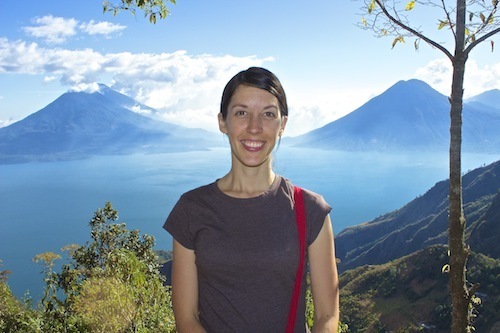
Original article can be found here: Vagabonding Field Report: Camping in Northern Mexico
On the corner of fate & Communism: Lessons in Hanoi
Vagablogging :: Rolf Potts Vagabonding Blog
“Travel is fatal to prejudice, bigotry, and narrow-mindedness, and many of our people need it sorely on these accounts. Broad, wholesome, charitable views of men and things cannot be acquired by vegetating in one little corner of the earth all one’s lifetime.” –Mark Twain The Innocents Abroad/Roughing It
It’s an interesting thing to be a guest in country that your father’s generation bombed to perdition with questionable motives. From the moment we hit the ground here I’ve been looking into the eyes of every man in his sixties and wondering how he sees me. If he hates my guts. If in another decade of his lifetime he’d have killed me where I stood just because my passport has a blue back with a golden eagle emblazoned on it. Would he have shot my uncles dead if he’d crossed paths with them in the jungle? Did my older friends drop the bombs that killed his entire family? His black eyes give no hints.
We watched a beautiful and ancient woman cross the street today in the middle of a rain storm. She pulled her long pants up around her knees and gingerly stepped through the puddles in her plastic sandals. She was wearing a traditional cone shaped “rice paddy” hat and was grinning from ear to ear without one tooth left in her head. It’s likely she’s lived her whole life in Hanoi. She was likely a girl under French colonial rule. She likely saw the rise of the Vietnamese revolution, the ousting of Japan and the establishment of a Vietnamese state in the north. She may have had sons who fought against my uncles. She would certainly have spent terrified nights while bombs fell only to clear away rubble by day and pray to whatever gods she may have that those she loved be spared. She surely buried people and part of her heart with them.
What does she think of me? Of my children? What would she say to me if she could?
I wonder these things as I wander the streets here, delighting in so much that is rich and achingly beautiful about this ancient culture.
We spent the day in history lessons, first hand: First, a visit to the mausoleum where Ho Chi Minh’s body is displayed (embalmed with the help of the Russians.) We saw his homes, where he lived up until 1954 as well as the newer stilt house he had built across the pond that he lived in after that. We saw his bomb shelter, just steps from his bedroom. We saw the beautifully preserved cars that were given to him as gifts from the Russians, and Vietnamese in France.
Hoa Lo Prison, the Hanoi-Hilton as most Americans know it, was sobering. It’s not just the prison that held American Airmen shot down over Vietnam, they were some of it’s last residents. It was a prison built by the French where Vietnamese revolutionaries were held, tortured and killed. When the Vietnamese took it over not much changed, it was just the roles that were reversed.
Everything we saw today was a first hand lesson in propaganda. Of course Vietnam is Communist. They achieved independence. They won their revolutionary war. They defeated the American “puppet-government” and we all know that history is written by the victorious. To hear them tell it, the American Airmen were treated better than the Vietnamese people themselves during their incarceration, including Christmas celebrations and top notch food and medical care. Of course the incarcerated tell very different versions of that story.
It was sickening to move from room to room and read the stories of mistreatment on all sides. Vietnamese women and children harmed horribly under the French. US Airmen with blank eyes telling one story while their captors told quite another in the video footage. I tried to imagine being locked in one of those rooms in my own filth for years on end. I tried to imagine my Dad, my Uncles, my husband… my sons. It is unimaginable, and yet, it happened. It is happening now around the world, at this very instant. It is a corner of the human heart, the human condition, our capacity for wrong doing that I simply cannot get my head around having lead the carefully, gently, tenderly treated life I’ve lead. And I know that, in and of itself, skews my perceptions and my ability to understand. I strive not to judge because I know that in the truest sense of the words, I cannot understand.
And then… we sit on the side of the road munching down doner-kebab sandwiches in happy food heaven, joking with the sons of the revolutionaries who are cooking for us and counting our kids, amazed that we have FOUR, as usual. The wizened, old, toothless crone crosses the street, the rain falls, horns honk, and here we are, in downtown Hanoi, with our children, celebrating Elisha’s 12th birthday.
He’s calling it his “Communist Birthday” because today has been one long lesson in Vietnamese history and their version of Communism. We took his picture in front of “Uncle Vladamir” in Lenin’s park. He got a t-shirt with “Uncle Ho” on the front, not because we in any way sympathize with Ho, just because that was what today’s lesson was and he wanted to remember where he’d been and who he’d celebrated his birthday with. He’s very proud of the t-shirt. I’m proud that he not only knows who Uncle Ho is, but that he understands that there are two, often very different, sides to the same story.
I don’t know what to say about today, and what we’ve learned. I don’t think I’ve lived long enough or had a broad enough experience in these things to have earned the right to say anything at all, except that we learned a lot. Our understanding is deepening, of ourselves, our culture and our government as well as that of the Vietnamese who are so very graciously welcoming us into their homes and their streets and who are stuffing our children with noodles and Pho as if they were their own.
Something occurred to me this evening when slapped hard in the face with the seething hatred and depth of pain that still lies beneath the surface on the American side of the experience. I’m very glad that I’m not often judged by the actions of my government or the governments of my country that have passed in the generations before my time. People are not refusing to feed me noodles because of President Johnson’s policies. I hope that the lesson my children take away is the same, that the Vietnamese are people, who serve a government that tells them only part of the story, just like us. I hope that they learn to separate the individual from international policy. I hope that they learn that in all countries, in all corners of the world are people, just like them, who are trying to cobble together a life out of their dreams and their realities. I hope that they can extend the same grace to the descendants of “enemies” that is being extended to us at this very moment, because it seems to me that that is the ultimate way to defeat the atrocities on both sides, to find a way to reach over and through them, allowing the next generation to build something new.
Original article can be found here: On the corner of fate & Communism: Lessons in Hanoi
April 8, 2013
It’s all about priorities
Vagablogging :: Rolf Potts Vagabonding Blog
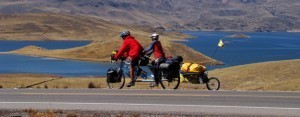 In the back of your mind you’re thinking you’d love to drop out of everything and take off to travel with your family for an extended period of time. C’mon – admit it.
In the back of your mind you’re thinking you’d love to drop out of everything and take off to travel with your family for an extended period of time. C’mon – admit it.
Maybe you aren’t interested in doing it on bicycles, but in a boat? Or on horseback? Or RV? Walking? Running maybe? Or perhaps you’d prefer using public transport of every conceivable variety?
You’d love to tell your boss you’re taking off – and actually do it.
But then you come back to reality. You’ve got a house you need to pay for. Car payments to make… Pay off those credit cards… Buy new furniture for your living room… And you need to save for retirement. Maybe that trip of a lifetime will never happen after all.
I would venture to guess that most people can take that trip of their dreams if they simply put their mind to it. It’s all a matter of priorities.
Now before you jump all over my back, I want to point out that little word “most” in the previous sentence. I do understand there are people out there who simply can’t take off for one reason or another, but for most, it’s doable. It comes down to priorities.
So how do you do it? How do you manage to save the money for a trip like this? Easy – you make it a priority. I’m not talking about giving the journey lip service – I’m saying you have to decide it really, honestly, truly is your priority. If it’s not, there will be a million other things to spend your money on.
Trim the Fat
I know, I know – you’ve heard this before: eliminate all expenses that aren’t necessary. Maybe you could stop buying that $5 coffee from Starbucks every morning, or carry your lunch rather than going out with the boys. You’ve read all that before.
But I think it comes down to something a bit different. I’m not necessarily saying to cut all that out, but to simply make conscious decisions. Remember – it’s all about priorities and making conscious decisions. Is that $5 coffee more important than your trip? Then, by all means, buy it. Lunch with the boys higher on the priority list than the journey? Then go for it. Just remember to make conscious decisions. Come back again and again to what is truly important in your life and make decisions based on that.
One of the people I respect the most is my sister-in-law. Years ago, Jane and her husband met us in while we were traveling and we spent a couple of delightful weeks together. Years later, we visited her in Colorado where we admired her newly refinished hardwood floors and reminisced about traveling.
“I enjoyed my time in Nepal,” Jane told me. “But I doubt I’ll travel like that again. I just don’t have the money.”
But then she took it a step farther. “No,” she added. “That’s not true. I do have the money – but I prefer to spend it on a new floor. At this point in my life, I think I would get more enjoyment out of a new floor or a new couch than I would out of a trip to Nepal.”
I have a tremendous respect for Jane and her honesty. I think most of us don’t actually make conscious decisions about our money. We see a need (a scratched floor or worn out couch) and spend our money to fix it. But we don’t tend to actually think about what will bring us more enjoyment in the long run. Jane is one of the rare people who actually did.
I think so often we get caught up in the whole “keep-up-with-the-Jones” thing and don’t even realize we are there. I remember years ago when I fell into that trap and it took me a while to realize I was in it.
I was living on the Navajo reservation at the time, and a group of us teachers got together each month to order food from a natural foods co-op. The ten of us gathered together in someone’s living room and pored over the catalog divvying up cases of this, that, or the other.
“I want three pounds of dried mangos,” I said. “Anybody want the other two pounds in the case?”
“A case of brown rice is 25 pounds – I can use five of them. Anybody else want some rice?”
“The coffee comes in five pound packages – I want two pounds of hazelnut. Want some?”
One of the standard purchases of our little co-op was coffee. Each month we ordered two or three varieties and divided them up between us all.
And every morning I religiously made my coffee, poured myself a cup, and carried it all over the house as I got ready. I never went anywhere in the morning without that cup of coffee – it went into the bathroom and waited while I took my shower. It sat beside the sink while I brushed my teeth. As I cooked my breakfast, my coffee cup was never far from the stove. And then when I took off for school, I left my cup of coffee sitting on my dining room table.
It took me three months to realize I never actually drank my coffee – I just carried it around. In all that time, I maybe actually drank one full cup of brew – one sip at a time. Even worse, it took me three months to realize I didn’t even like coffee! I had gotten so entrenched in “doing what everybody did” that I didn’t even think about it. Everybody made and drank coffee in the morning, so I did too. I was simply keeping up with the Joneses – and wasn’t even aware I was doing it.
Are you trying to keep up with the Joneses? Is there something in your life that you are doing just because? Reevaluate everything and make conscious decisions.
I’m not suggesting you give up everything. Not at all. I don’t believe we should be miserable in order to save money for a trip, just like I don’t believe we should be miserable now in order to save money for retirement. What I am saying is to simply make conscious decisions. Think about each and every item you spend money on and make a conscious decision – ‘is this item higher on the priority list than my trip?’
Some people decide that a Starbucks coffee each morning is worth delaying their journey a while; others make the opposite decision. Some people decide a new couch in their living room is worth putting their trip off for; others would rather shop at thrift stores or yard sales. The level of frugality we each feel we can deal with is a personal matter, and we each need to reevaluate our own needs and wants on a very regular basis. While I have no problem whatsoever using hand-me-down, unmatched furniture in order to save money for my travels, another person would find that to be an intolerable sacrifice.
I challenge you to think about your wants and needs this year. Make a list of priorities and make conscious decisions to work your way toward the items that are high on the list. You think you might surprise yourself!
This article originally appeared on www.familyonbikes.org.
Nancy Sathre-Vogel is a long-time schoolteacher who made the decision to leave her teaching career behind to travel the world on a bike – with her children. All told, they spent four years cycling 27,000 miles throughout the Americas. She blogs at familyonbikes.org
Original article can be found here: It’s all about priorities
April 7, 2013
Marshall McLuhan on how the modern traveler has become passive
Vagablogging :: Rolf Potts Vagabonding Blog
“The photograph has reversed the purpose of travel, which until now had been to encounter the strange and unfamiliar. Descartes, in the early seventeenth century, had observed that traveling was almost like conversing with men of other centuries, a point of view quite unknown before his time. For those who cherish such quaint experience, it is necessary today to go back very many centuries by the art and archaeology route. Professor Boorstin seems unhappy that so many Americans travel so much and are changed by it so little. He feels that the entire travel experience has become “diluted, contrived, prefabricated.” He is not concerned to find out why the photograph has done this to us. But in the same way intelligent people in the past always deplored the way in which the book had become a substitute for inquiry, conversation, and reflection, and never troubled to reflect on the nature of the printed book. The book reader has always tended to be passive, because that is the best way to read. Today, the traveler has become passive. Given travelers checks, a passport, and a toothbrush, the world is your oyster. The macadam road, the railroad, and the steamship have taken the travail out of travel. People moved by the silliest whims now clutter the foreign places, because travel differs very little from going to a movie or turning the pages of a magazine. The “Go Now, Pay Later” formula of the travel agencies might as well read: “Go now, arrive later,” for it could be argued that such people never really leave their beaten paths of impercipience, nor do they ever arrive at any new place. They can have Shanghai or Berlin or Venice in a package tour that they need never open. In 1961, TWA began to provide new movies for its trans-Atlantic flights so that you could visit Portugal, California, or anywhere else, while en route to Holland; for example. Thus the world itself becomes a sort of museum of objects that have been encountered before in some other medium. It is well known that even museum curators often prefer colored pictures to the originals of various objects in their own cases. In the same way, the tourist who arrives at the Leaning Tower of Pisa, or the Grand Canyon of Arizona, can now merely check his reactions to something with which he has long been familiar, and take his own pictures of the same.”
–Marshall McLuhan, Understanding Media: The Extensions of Man (1964)
(1964)
Original article can be found here: Marshall McLuhan on how the modern traveler has become passive
April 4, 2013
Vagabonding and the Asian mind
Vagablogging :: Rolf Potts Vagabonding Blog

Picture credit: Flickr/ Marcio Cabral de Moura
Living in Asia and trying to have real, normal friends can often bring to “that” conversation topic: travel. And whenever I say I have been to 50 countries, my friends roll eyes and vent out some long, strange sounds before freezing in awe with open mouths. Then, their jaws drop for about 10 seconds, and the dire question always comes up next.
“How can you do it? Are you RICH?”
No, I’m not and it seems that – like in the West – most Asians cannot conceive travel without a sackcloth bag full of cash tied to their waist. What’s more, to them travel is to shell out on something they cannot have at home. Understandable: if I also lived in a tiny house with too many people, I think I would enjoy spending a weekend at the local Holiday Inn laying by the poolside.
When I start to explain how I like to travel, and how I like to do things that they consider dangerous, downright crazy or just plain boring, they lose interest and continue sipping their drinks.
Their curiosity, however, surprises me. To the contrary of most Western folks of all ages, Asians probably have a deeper sense of responsibility towards their families, or are just less inclined to “leave it and risk it”. Japanese and some Koreans have been an exception, but not casually, their currency is stronger than most other Asians. It seems that the main problem between their desire for vagabonding, and the actual realization of their dream, is fear of not having enough money to make it.
So, they think I am rich.
I do not even own an Ipad like the one they are toying with as we speak. For one of those, they are not afraid to pay roughly one month’s salary …. funny, isn’t it?
Maybe it is all related to a matter of priorities, and everything will change when Asians will realize that trying to be Western actually leads to – errr… – escapism and vagabonding. We can just wait, and see what the future will bring…
Original article can be found here: Vagabonding and the Asian mind
April 2, 2013
Vagabonding Field Report: The Biggest Starfish On The Smallest Island In The World
Vagablogging :: Rolf Potts Vagabonding Blog
Cost/day: $80/day
What’s the strangest thing you’ve seen lately?
I discovered the smallest island in the world in Sumatra. It’s made entirely of sand, and it’s covered in starfish. The locals call it Sand Island. It’s off the coast of Belitung Island in Southern Sumatra. The island is so small that there isn’t even a palm tree. But lots of starfish float upon it’s shores, and they are the biggest starfish that I’ve ever seen.
Describe a typical day:
Well, it’s an island, so getting there isn’t the easiest. First you have to get to Belitung Island. Belitung isn’t even in the Lonely Planet yet, so there are no taxi’s. Drivers do come to the airport to take you to your hotel. So I arranged for the driver at the airport to be my full-time driver while I am here for $40 a day. He arranged a boat tour for me to go to Sand island and lots of other islands all covered in huge granite stones. That is another $40 a day.
Describe an interesting conversation you had with a local:
No one speaks English here, and I mean no one. My driver has been using Google Translate on his phone to ask questions. I thought this was a brilliant idea. We also talked about what music we liked. They are also very proper here, and he started out the day by asking whether he should call me Madame or Miss.
What do you like about where you are? Dislike?
I love the beauty of the beaches on Belitung and the surrounding islands. I cannot get over the size of the huge granite rocks which loom overhead. I hate the amount of trash on the beaches. I wish people respected the environment more.
Describe a challenge you faced:
I suddenly found myself climbing a twenty-story lighthouse in my bare feet. The stairs were covered in rust. They were steep and narrow. The driver had insisted that I go all the way to the top. I have no idea why I had agreed to that. I got to the top and was too afraid to even go out on the landing because the metal was so rusty, I was afraid it would collapse. Going back down, the stairs were so narrow that everytime I stepped down a stair, the stair above would scrape my calves. I am so glad that I had a tetanus shot before coming on this trip!
What new lesson did you learn?
I learned that to get to the beautiful places in life, you sometimes have to go through a bit of discomfort to get there. It is the same in ourselves. To uncover the hidden beautiful places in ourselves, we sometimes have to go through some uncomfortable growing pains to see them!
Where next?
I’m off to Ubud, Bali. My favorite place in the world, and the place I currently consider to be my true home. For more on my visit to Sumatra, check out my blog or Facebook!
Original article can be found here: Vagabonding Field Report: The Biggest Starfish On The Smallest Island In The World
Theft Prevention: Why you should drag your backpack behind your bike
Vagablogging :: Rolf Potts Vagabonding Blog
This week a friend of mine had her iPhone stolen in Antigua. It’s ignited another round of discussions in our traveling circles about theft on the road, how to avoid it and the various gear and gadgets marketed to minimize the likelihood of being burgled on the road.
I would like to say two things about this:
If you travel long enough, something’s going to get stolen. That’s just the way of it. If you adjust your mind to that from the beginning you won’t be surprised when it happens and maybe you’ll feel a little less violated as well.
The best way to prevent it is to look like you’ve got nothin’.
When we were kids we spent a couple of winters rolling around Central America. My Dad’s philosophy included a commitment to blending in and keeping a low profile as much as a family of gringos could.
“If you look like you’ve got less than the locals, then no one has a reason to take your stuff,” was his conclusion.
It’s one I’ve come to share over the years.
Traveling with fancy “traveling” clothes, an obvious “gadget bag” and a shiny new backpack is the surest way to paint a target on your back before you even leave the airport. There are lots of reasons that an iPhone might be a great piece of gear to take along on an extended journey, especially if you’re working as you go, but if you don’t need it… don’t take it. Buy the $10 cell phone when you hit the ground and swap out the SIM card in each country. Take clothes that are clean and respectable looking, but not new with the tags from REI still dangling off the back. The fancy gear yells MONEY loud and clear, to locals and opportunistic other travelers alike. A brand new backpack screams, “It’s my first rodeo!!” like little else, marking you as someone who is neither hip to the road groove, or experienced enough to smell a con.
Most everyone you’ll meet on the road is a good person, a friend in the making. But the very few and far between who are out to prey on travelers have a keen eye and know exactly who they’re looking for. The surest way to “not be that guy” is to follow my Dad’s advice, travel with a low profile.
And, if you absolutely MUST buy a new bag, drag that thing behind your bike for half of a mile before you pack it.
Have you had anything stolen on the road? What steps do you take to prevent it?
Original article can be found here: Theft Prevention: Why you should drag your backpack behind your bike
April 1, 2013
What’s your exit strategy?
Vagablogging :: Rolf Potts Vagabonding Blog
 There are many wonderful aspects of being a long term perpetual traveler. There are dozens of names for them – digital nomad, lifestyle design, location independent, world wanderer – but they are all basically names for the same thing: a person who travels the world with no plans to ever settle down in one place. It’s a wonderful lifestyle with many benefits. It’s also extremely difficult to break out of when it’s no longer meeting your needs.
There are many wonderful aspects of being a long term perpetual traveler. There are dozens of names for them – digital nomad, lifestyle design, location independent, world wanderer – but they are all basically names for the same thing: a person who travels the world with no plans to ever settle down in one place. It’s a wonderful lifestyle with many benefits. It’s also extremely difficult to break out of when it’s no longer meeting your needs.
Many of us head out to travel long term without considering an exit strategy. As we plan our world travels it’s all pie in the sky, glamour, and exotic every night. It’s fun, fun, fun in new and exciting places. Our thoughts are filled dreams of the wonderful adventures we’ll have in remote corners of the world.
Once we hit the road, we quickly discover the reality of travel isn’t glamorous at all. It’s long hours battling headwinds on hot, dusty roads or being crammed in a bus built for little people. It’s sleeping on uncomfortable mattresses in noisy hostels. It’s craving Grandma’s Cranberry Salad, but not being able to find the ingredients to make it. Even so, we’re willing to endure the distinctly un-glamorous for the intoxicating excitement of the bits in between.
But we rarely think about how to stop.
A friend of mine recently said, “I’m tired of travel, but I’ve been on the road so long I don’t know how to stop.”
It’s important that we take time to think about when it’s time to call it quits; to develop an exit strategy for our travels. When has the travel fulfilled our needs and we would be better served by another lifestyle? How do we know when it’s time to move on, so to speak – to leave the traveling behind and explore other avenues in life?
One way to define that is to think about what you hope to gain through your travels – whether you are just starting out or have been on the road for years. What do you want to learn from traveling and how will you know you’ve learned it? If you aren’t sure where you’re going, how will you know you’ve gotten there?
I am a strong proponent of setting a particular goal – and when you reach that goal, take time to reevaluate. For us, it was a physical goal – reaching Ushuaia. When we reached that goal after three years on the road, it forced us to take a good long look at what we wanted to do next. Would continued travel on bikes be of the most benefit to all four of us? Or should we travel another way? Or should we stay in one place?
The goal, however, doesn’t have to be a physical goal. It can be a certain amount of time or when you’ve reached a certain level of comfort in your new lifestyle. The goal can be anything you want it to be – but define the goal carefully so you will know when you’ve reached it. Once you are at your goal, take a good hard look at your lifestyle and see if it is still meeting your needs and wants. Give yourself permission to change gears if it isn’t.
As we travel through life on this planet, our needs, wants, and desires change and develop. It’s important that we are receptive to those changes and willing to respond to them. Don’t fall into the trap of just another rat race – albeit a rat race around the world. Just as you can spin on the hamster wheel in your hometown, you can quite easily take the hamster wheel with you.
Don’t be afraid to jump off.
Original article can be found here: What’s your exit strategy?
March 31, 2013
Revolutionary technological changes are not a new thing
Vagablogging :: Rolf Potts Vagabonding Blog
“New devices, new methods, new machines to make new products, new proofs of the power of the human mind to conceive and the human hand to construct instruments with which to conquer the forces of nature and bring them to the service of humanity — these are the characteristics of the age we live in. Never have the creative forces of mankind moved so fast as in the lifetime of us who are now on earth. Never before have there been so many people in the world eager to know what the world is doing, and how it is doing it.”
–Frank Parker Stockbridge, “Comment and Review,” Popular Mechanics, April 1913
Original article can be found here: Revolutionary technological changes are not a new thing
March 29, 2013
Vagabonding Case Study: Adam Pervez
Vagablogging :: Rolf Potts Vagabonding Blog
Adam Pervez
Age: 30
Hometown: Strongsville, Ohio
Quote: “Know yourself as well as possible and organize your trip based on your personality. Go with your own flow, not the flow of others.”
How did you find out about Vagabonding, and how did you find it useful before and during the trip?
I found out because you interviewed my friend Jasmine.
How long were you on the road?
I have been on the road for 13 months.. and I’m still going!
Where all did you go?
In order: Mexico, Guatemala, Honduras, El Salvador, Nicaragua, Costa Rica, Panama, Colombia, Venezuela, Ecuador, Peru, USA, UK, Singapore, Vietnam, Cambodia, Laos, Thailand, Philippines
What was your job or source of travel funding for this journey?
I previously worked as a business development specialist with a wind power company in Denmark. Right now I
Did you work or volunteer on the road?
I volunteer on the road, doing whatever I can to leave each place a bit better than how I found it. I also write for The Singapore Business Times.
Of all the places you visited, which was your favorite?
It’s very hard to say, but Peru has something special. Apart from the Inca ruins, the cities at extremely high altitudes, the numerous climate zones that allow you to enjoy every kind of weather, the great food.. I don’t know. There’s something special about the place that’s hard to put a finger on.
Was there a place that was your least favorite, or most disappointing, or most challenging?
I would say Central America is a bit challenging due to security. I was robbed in Guatemala, though since I didn’t understand his Spanish the thief didn’t get my stuff. In Honduras I heard gunshots as two guys shot and killed each other one street away from where I was staying. When security is on your mind every time you step out the door, it weighs on your overall enjoyment and satisfaction no matter how amazing and beautiful the place is.
Did any of your pre-trip worries or concerns come true? Did you run into any problems or obstacles that you hadn’t anticipated?
Continuing with the safety theme, I was worried about getting robbed and it happened in Colombia as well. That time it got a bit physical.
As for problems I didn’t anticipate, not too many. I had traveled extensively before The Happy Nomad Tour. But I have been sick every year this month with either diarrhea, a head cold, or both. I didn’t expect to get sick so often.
Which travel gear proved most useful? Least useful?
My head mounted LED came in handy many times. I never used my STERIPEN though.
What are the rewards of the vagabonding lifestyle?
There are too many to name. But it’s magical in terms of personal development, confidence-building, relating to the world, becoming a global citizen, and getting to know your fellow man.
What are the challenges and sacrifices of the vagabonding lifestyle?
The challenges involve the learning curve when getting to new places and figuring out how things work. If you are on a shoestring it’s challenging how to figure out how to do things as cheaply as possible. Logistics and safety can be quite challenging as well.. also letting go and accepting when things don’t go “correctly.”
As for sacrifices, I guess the comforts from home and the proximity to friends and family.
What lessons did you learn on the road?
Too many to list, but in essence, we’re all the same just trying to improve our personal and family situations.
How did your personal definition of “vagabonding” develop over the course of the trip?
I think it’s pretty much stayed the same since I traveled extensively before starting The Happy Nomad Tour and knew what I wanted out of this adventure.
If there was one thing you could have told yourself before the trip, what would it be?
Don’t forget that every day of this trip is living out your dream, so never forget to be grateful for this experience you’re about to have!
Any advice or tips for someone hoping to embark on a similar adventure?
Know yourself as well as possible and organize your trip based on your personality. Go with your own flow, not the flow of others. And try not to say no to any opportunities. They usually end up being amazing 
When and where do you think you’ll take your next long-term journey?
I’m still going! I’m in The Philippines now, next Myanmar, Nepal, hopefully Tibet, India, Pakistan, Middle East, etc.
Website: HappinessPlunge.com
Twitter: HappinessPlunge
Are you a Vagabonding reader planning, in the middle of, or returning from a journey? Would you like your travel blog or website to be featured on Vagabonding Case Studies? If so, drop us a line at casestudies@vagabonding.net and tell us a little about yourself.
Original article can be found here: Vagabonding Case Study: Adam Pervez
Rolf Potts's Blog
- Rolf Potts's profile
- 323 followers




